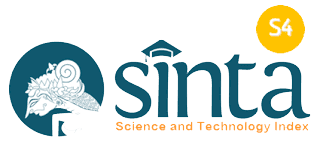Policy Implementation of 9 Years of Compulsory Learning Program and Eradication of Illute Illusion In Nabire District
(1) STMIK Pesat Nabire, Nabire, Papua, Indonesia
(*) Corresponding Author
DOI: https://doi.org/10.26858/pdr.v5i1.23702
Abstract
Education has an important role in the process of improving the quality of human resources. Improving the quality of education is an integrated process in the process of improving the quality of human resources. The role of education is very much needed and demands attention and participation from all parties. In Article 31 of the 1945 Constitution, education is a right for every citizen, the Government is well aware of the need to improve the quality of education as a tool to improve the quality of human resources. Through Law No. 20 of 2003 concerning the national education system and Presidential Instruction No. 5 of 2006 2006 concerning the National Movement for the Acceleration of Completion of Compulsory Education for Nine Years of Basic Education and Eradication of Illiteracy. Therefore, there are still many children who drop out of school, especially in Nabire Regency. Most children drop out of school because of a lack of awareness of the importance of education and the role of parents in encouraging their children. In addition, the school environment that affects student learning includes classroom infrastructure, inadequate and inadequate building conditions. In this study using qualitative research methods, namely a study aimed at describing and analyzing phenomena, events, social activities, attitudes, beliefs, perceptions, thoughts of people individually and in groups. Qualitative research, data collection is carried out in natural conditions, primary data sources, and data collection techniques are mostly on instrumental observation, as well as in-depth interviews. This study concludes that the implementation of the 9-year compulsory education program policy in Nabire sub-district has not been implemented effectively due to inconsistency. Then policy implementers have not given a positive attitude which is marked by weak coordination in policy implementation.
Keywords
Full Text:
PDFReferences
Bahri, B., Sumaryana, A., Karnaesih, E., & Karlina, N. (2019). The Implementation of the Allocation and Distribution of School Operational Assistance Program for Compulsory Education Units in Kuningan Regency, West Java Province. Journal of Social Studies Education Research, 10(1), 178–192.
Botituhe, N., Akib, H., & Gani, H. A. (n.d.). Strategy Formulation through Identification Of Asset Management Problem Of The Gorontalo City Government.
Griffin, P., Care, E., & McGaw, B. (2012). The changing role of education and schools. In Assessment and teaching of 21st century skills (pp. 1–15). Springer.
Jain, R., Sinha, G., & Sahney, S. (2011). Conceptualizing service quality in higher education. Asian Journal on Quality.
Jamshed, S. (2014). Qualitative research method-interviewing and observation. Journal of Basic and Clinical Pharmacy, 5(4), 87.
Khan, S. N. (2014). Qualitative research method: Grounded theory. International Journal of Business and Management, 9(11), 224–233.
Krishnaveni, R., & Meenakumari, J. (2010). Usage of ICT for Information Administration in Higher education Institutions–A study. International Journal of Environmental Science and Development, 1(3), 282–286.
Legewie, J., & DiPrete, T. A. (2014). The high school environment and the gender gap in science and engineering. Sociology of Education, 87(4), 259–280.
Liñán, F., Rodríguez-Cohard, J. C., & Rueda-Cantuche, J. M. (2011). Factors affecting entrepreneurial intention levels: a role for education. International Entrepreneurship and Management Journal, 7(2), 195–218.
Martin, A., & Olson, K. R. (2015). Beyond good and evil: What motivations underlie children’s prosocial behavior? Perspectives on Psychological Science, 10(2), 159–175.
Masry-Herzallah, A. (2021). Education for Multiculturalism in a Master’s Degree Program in Policy and Administration in Education: Comparing Jewish and Arab Students in Israel. European Journal of Educational Research, 10(2), 757–772.
McGrath, S. (2012). Vocational education and training for development: A policy in need of a theory? International Journal of Educational Development, 32(5), 623–631.
One, T., & Two, T. (2014). Human resources management.
Pala, A. (2011). The need for character education. International Journal of Social Sciences and Humanity Studies, 3(2), 23–32.
Radsch, C. C., & Khamis, S. (2013). In their own voice: Technologically mediated empowerment and transformation among young Arab women. Feminist Media Studies, 13(5), 881–890.
Rahardja, U., Hidayanto, A. N., Hariguna, T., & Aini, Q. (2019). Design framework on tertiary education system in Indonesia using blockchain technology. 2019 7th International Conference on Cyber and IT Service Management (CITSM), 7, 1–4.
Smith, S., Barajas, K., Ellis, B., Moore, C., McCauley, S., & Reichow, B. (2021). A meta-analytic review of randomized controlled trials of the good behavior game. Behavior Modification, 45(4), 641–666.
Snell, S., Morris, S., & Bohlander, G. W. (2015). Managing human resources. Cengage Learning.
Sulistyaningrum, E. (2016). Impact evaluation of the school operational assistance program (BOS) using the matching method. Journal of Indonesian Economy and Business, 31(1), 33–662.
Sunusi, S., Makmur, M., Tawe, A., & Tahir, H. (2014). The Implications Of The Development Strategy Of Local Government Officials Resources. International Journal Of Academic Research, 6(5), 39–43.
Teeroovengadum, V., Kamalanabhan, T. J., & Seebaluck, A. K. (2016). Measuring service quality in higher education: Development of a hierarchical model (HESQUAL). Quality Assurance in Education.
Article Metrics
Abstract view : 247 times | PDF view : 33 timesRefbacks
- There are currently no refbacks.
Copyright (c) 2021 Arief Rahman Hakim


































